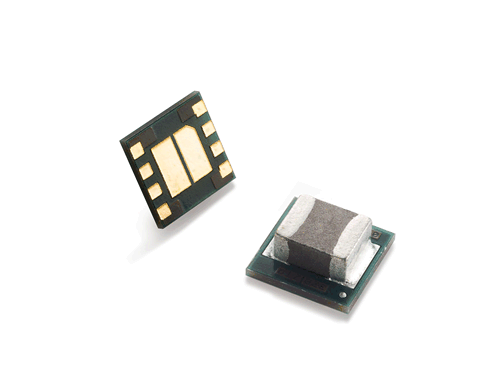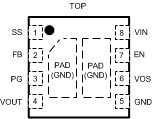SNVS872D August 2012 – August 2018 LMZ21700
PRODUCTION DATA.
- 1 Features
- 2 Applications
- 3 Description
- 4 Revision History
- 5 Pin Configuration and Functions
- 6 Specifications
- 7 Detailed Description
- 8 Application and Implementation
- 9 Power Supply Recommendations
- 10Layout
- 11Device and Documentation Support
- 12Mechanical, Packaging, and Orderable Information
Package Options
Refer to the PDF data sheet for device specific package drawings
Mechanical Data (Package|Pins)
- SIL|8
Thermal pad, mechanical data (Package|Pins)
Orderable Information
5 Pin Configuration and Functions
 Figure 1. LMZ21700 in the SIL0008E Package
Figure 1. LMZ21700 in the SIL0008E Package
µSIP Package
8-Pin SIL
Top View

Pin Functions
| PIN | I/O | DESCRIPTION | |
|---|---|---|---|
| NO. | NAME | ||
| 1 | SS | I | Soft-start pin. An external capacitor connected to this pin sets the internal voltage reference ramp time. It can be used for tracking and sequencing. |
| 2 | FB | I | Voltage feedback. Connect resistive voltage divider to this pin to set the output voltage. |
| 3 | PG | O | Output power good (High = VOUT ready, Low = VOUT below nominal regulation); open drain (requires pull-up resistor; goes low impedance when EN is low) |
| 4 | VOUT | O | Output Voltage. Connected to one terminal of the integrated inductor. Connect output filter capacitor between VOUT and PGND. |
| 5 | GND | I | Ground for the power MOSFETs and gate-drive circuitry. |
| 6 | VOS | I | Output voltage sense pin and connection for the control loop circuitry. |
| 7 | EN | I | Enable input (High = enabled, Low = disabled). Internal pull down resistor keeps logic level low if pin is left floating |
| 8 | VIN | I | Supply voltage for control circuitry and power stage. |
| PAD | Electrically connected to GND. Must be soldered to a ground copper plane to achieve appropriate power dissipation and mechanical reliability. | ||